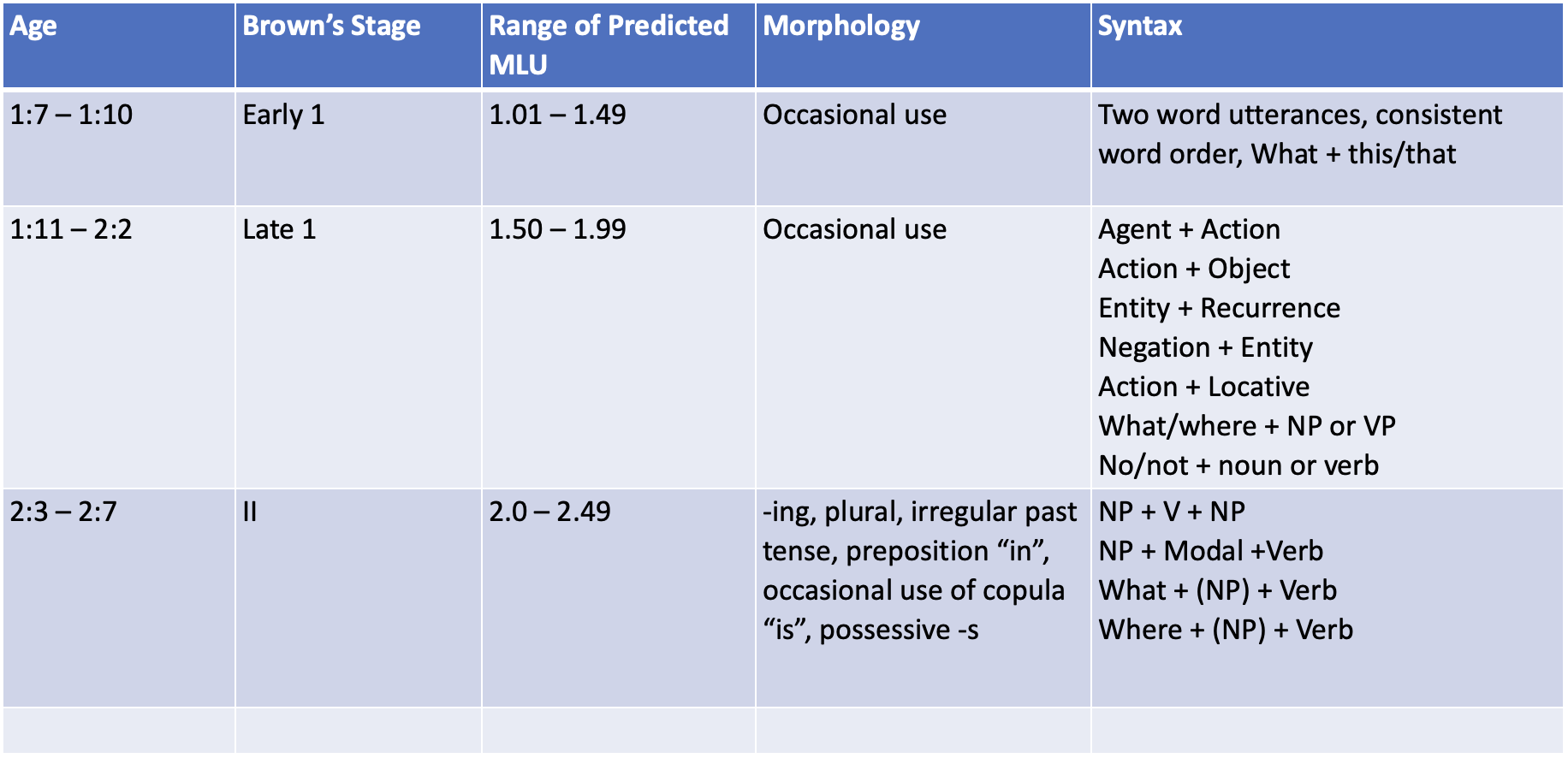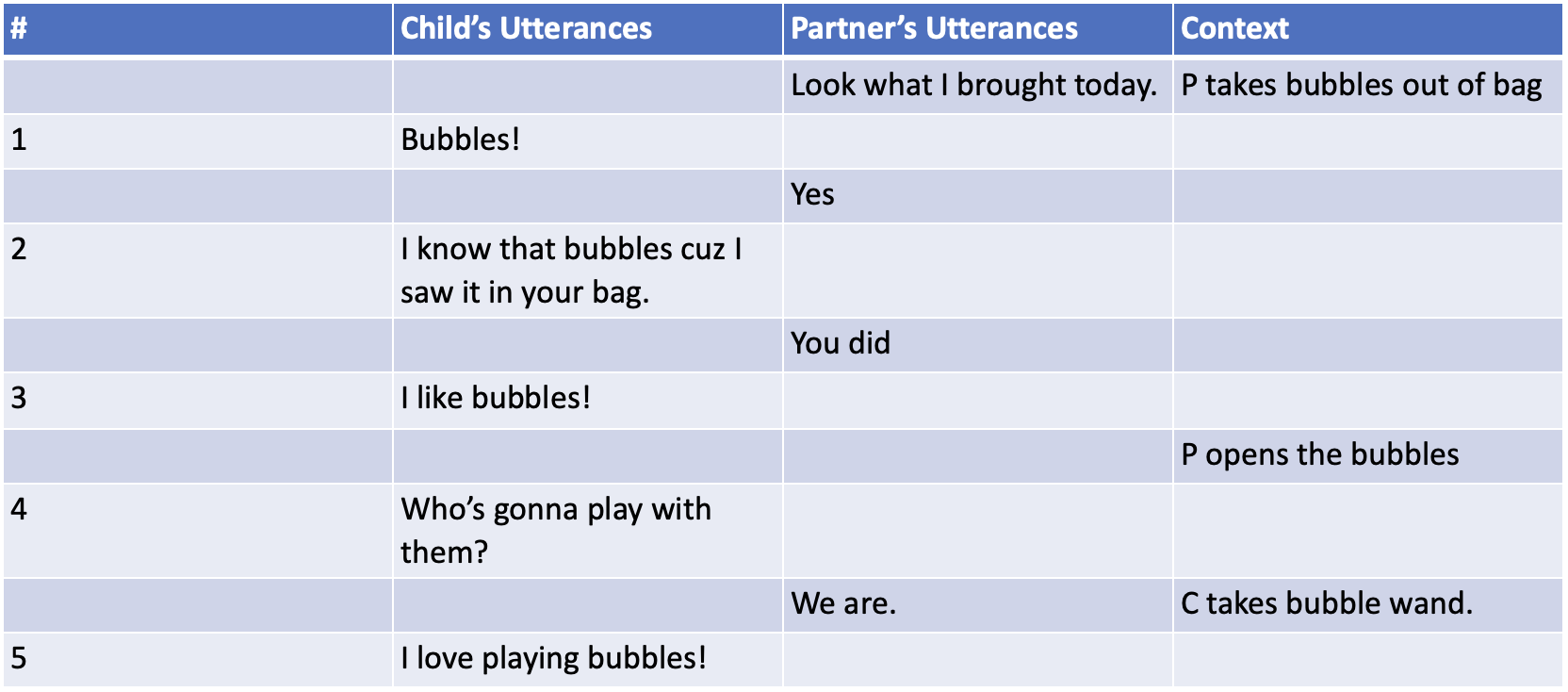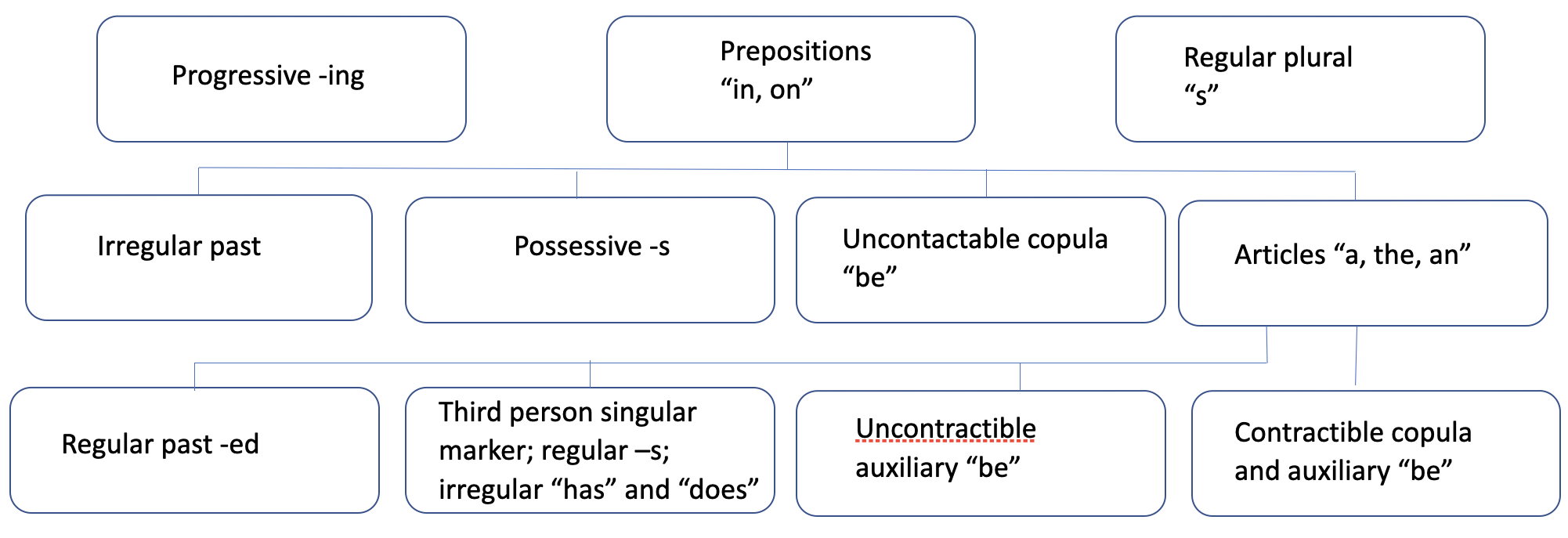Ch. 9 - The Development of Morphology and Syntax
Introduction
- Words carry much of the meaning (or “content”) of a sentence
- The size of our mental library of words (referred to as the %%lexicon%%) increases dramatically over our lifetime as new experiences lead to the discovery of knowledge about new objects, concepts, ideas, and words
- In order to express more complex concepts, children must acquire the ability to string words together into longer and more complex sentences
- The production of %%discourse%% requires the integration of multiple linguistic systems, including morphology and syntax
- All languages have rules for the way to combine words into sentences
- %%Syntax%%: word order
- For meaningful communication to occur, speakers and listeners need to agree not only on the meanings of particular words, but also on meanings that are conveyed by word order
- Bound/unbound morphemes
- Derivational morpheme: changes the grammatical categories of words, acquired well into school age years ex. bake to baker; quick to quickly
- %%Grammar%%: the form of language
Learning About the Development of Morphology and Syntax
- Language sample: 100 words
- Write down the utterances that were spoken by the adult and the child
- Analyze vocabulary, morphology, and syntax
- Roger Brown (1973)
- Tied linguistic development to increase in utterance length
- MLU = mean length of utterance
Key Milestones in Morphological Syntactic Development



Learning About the Development of Morphology and Syntax
- MLU is the average number of morphemes per utterance
- MLU is calculated by counting the number of free and bound morphemes contained in each utterance and dividing the total morphemes by the total number of utterances in the sample
- Computing MLU is a relative quick to estimate where a child is in the language development process
- MLU is a relatively good predictor between 1-5 years
Computing MLU
Utterances that are incomplete or unintelligible are excluded from the analysis
False starts, repetitions, and fillers (uh) are not counted because they don’t add to the meaning of the utterance
Leave it in the water (5)
That’s dirty (4)
Go night-night (2)


Total # of Morphemes: 30
Divide by 5 (number of utterances): 30/5
MLU: 6
Precursors to Syntax
- There are a number of cognitive and linguistic prerequisites to the development of syntax
- Children exhibit sequenced behavior (pour drink into a cup and then drink)
- 18 months – 2 years children produce 2 word utterances (agent+action, action+location)
- Children in the pre-syntactic stage of language development have learned concrete patterns of words that co-occur frequently
- Mommy go
- These 2 word utterances are not considered to be syntactic
- The key to syntactic development is an important discovery that a child makes about the position of words and phrases in sentences
- The ability to recognize that similar meaning relationships can be expressed by different word orders is called distributional analysis
- Chompsky - you’re born with the knowledge of grammar (or grammar needing to happen) - generation of novel sentences with grammar structure (don’t have to only repeat what has been heard)
- Fluffy, stop scratching the couch
- The cat scratched the couch
- Stop scratching the couch, Fluffy.
Early Syntactic Development: Combing Words into Sentences
- All languages have rules for the way to combine words into sentences.
- Syntax: the allowable patterns for combining words into sentences
- Knowledge of syntax or word order matters because the same words denote different meanings when their order is changed
- The ability to form grammatically correct sentences requires more than knowledge or word order
- Sometimes the words need to be changed somewhat depending on their role in the sentence (morphemes)
- Between 2-3 years of age: move from using 2-3 word utterances to using sentences that that can contain up to 5-6 words
- Declarative sentences are expressed first
- Subject + verb + object
- Roger Brown identified 14 grammatical morphemes that appeared relatively frequently in young children’s language
Brown’s 14 Morphemes

The Developmental Process
- 2 theories in of early syntactic development
- Generativist theories (“nature”)
- That an innate universal grammar provides children with an understanding of abstract syntactic categories such as verb test (present, past, future) and agreement (person and number) and the abstract operation needed to create a variety of grammatical constructions
- Usage based constructivist theories (“nurture”)
- Children’s early linguistic productions reflect their knowledge of word sequences that occur frequently in the language that children hear
- Children gradually develop knowledge of abstract syntactic categories over time and notice overlap
- Correct use of a variety of constructions should emerge slowly after a significant amount of lexical learning
- Regression occurs during early morphological development
- Children increase their use of a new structure and later appear to lose the new skill
- Rote learning precedes rule learning
- Example: I cut my finger (rote)
- Learn regular past tense (overgeneralization): I cutted my finger
- Learn rules for both regular and irregular past tense: I cut my finger
- Preschoolers are grammatically accurate 71% of the time
- 1/3 errors involve tense marking
Later Syntactic Development: Combining Phrases and Clauses
- Noun and verbal phrase development involves distinct rules of word order and syntactic marking that become more complex over time
- Children progress from elaborating noun and verbal phrases to producing complex sentences through the process of phrasal and clausal conjoining and embedding
Development of Noun Phrases from Preschool to School-Age
Phrase Development
Indefinite article a & demonstrative that
Subject pronouns (I, he. she, we, they)
Object pronouns (me. him. her, us, them)
Reflexive pronouns (myself, himself, herself, ourselves)
Possessives, quantifiers, physical attributes
Elaboration in subject and object positions using adjectives
Relative clauses that modify nouns
Multiple noun phrases used in succession
Post noun modifiers in embedded phrases and clauses
The Developmental Sequence
- Syntactic structures begin to appear around 3 years of age (MLU 3.0-3.49)
- Can use:
- “be” verbs (Tommy is washing)
- Auxiliary “do” (I don’t drink tea)
- %%Modal verbs%% (I could go over there)
- Combine sentences with “and”
- Use simple infinite forms (I like to eat fried chicken)
- Questions with auxiliary inversion (Are you coming over to my house?)
A %%modal verb%% is a type of verb that is used to indicate modality - that is: likelihood, ability, permission, and obligation. Examples include the English verbs can/could, may/might, must, will/would, and shall/should.
- Late in their 3rd year
- MLUs 3.75-4.5 (stage V)
- Variety of complex sentences
- %%Adverbial clauses%%
- %%Definite and indefinite articles%%
- Contracted forms of auxiliary verbs
An %%adverbial clause%% is a group of words which plays the role of an adverb. (Like all clauses, an adverbial clause will contain a subject and a verb.)
Keep hitting the gong hourly. (normal adverb) Keep hitting the gong until I tell you to stop.
(adverbial clause)
The difference between %%definite articles%% and %%indefinite articles%% is that the definite article is used when referring to a specific person, place, idea, or thing, but the indefinite articles are used when referring to a noun in the more general sense. The definite article is the.
The indefinite article is a / an
- 4th year of life (MLU=4.5-5.63)
- Subjective relative clauses
- Conjunctions (because, when, so)
- %%Gerunds%% (skiing is my favorite sport)
- Multiple phrases and clauses
%%Gerunds%% function as nouns in the sentence. Typically, a gerund is used as a thing or an idea, and gerunds always end in -ing. An example of a gerund is “Playing on computers is fun.”
- Kindergarten
- %%Passive forms%% (the cat was chased by the dog)
- %%Tag questions%% (Awful day, isn’t it?)
- Perfect tense (has, had, will have)
- Elementary years
- Children's use of literature language structures increases markedly
Verbs are either active or passive in voice. In the active voice, the subject and verb relationship is straightforward: the subject is a do-er. In the passive voice, the subject of the sentence is not a do-er. It is shown with by + do-er or is not shown in the sentence
- By 12-14 years of age, written language becomes more complex than their oral language
- By adolescence, children should have adult-like syntax and morphology in their speaking and their writing
- 3 influences on later syntactic development
- Exposure to written language
- An increase in working memory capacity
- New ways of relating language to thought (talk about things that are not present)
Morphological/Grammatical Learning in Late Talkers and Children with Specific Language Impairment (SLI)
- Preschool
- Late talker: slow expressive language development
- About 50% will “catch up” with their peers with no intervention
- Linguistic proficiency is commonly measured in young preschool children by eliciting a conversational sample and calculating mean length of utterance
- SLPs use MLU along with other measures of linguistic ability to make decisions about whether to recommend intervention for late talkers
- Measures of vocabulary were highly correlated with measures of grammar over time
- Vocabulary skill was shown to be a strong, consistent predictor of later grammatical skills
- Grammatical impairments are a known risk factor for language impairment
School-Age
- SLI 7% of kindergarten
- SLI: state in which children demonstrate significant language learning difficulties in the absence of cognitive, hearing, oral-moto, emotional, or environmental deficits
- Demonstrate weakness in the development of morphosyntax, specifically in using inflectional morphemes
- Analysis of oral narratives or stories may be used to document linguistic proficiency for school-age children because increasing grammatical and syntactic abilities are related to improvements in the overall organization of narratives
- Tell story, segmented into %%C-units%%
- C-units - number of phrases in a sentence ex. I went to the store and bought milk. (2)
- Individual utterances are analyzed for linguistic form and content
- %%Total number of words (TNW), number of different words (NDW)%%
- MLU
- % of complex sentences (contain a main clause and a subordinate clause)
- Compared to data (table 9.7)
What is inflectional morphology?
- Children with SLI also demonstrate difficulty organizing stories and using appropriate vocabulary
- Analysis of oral narratives or stores may be sued to document linguistic proficiency
- Total number of words, number of different words, MLU, % of complex sentences (table 9.7 means)
What Causes SLI
- Linguistic and processing
- Linguistic accounts of SLI traditionally highlight problems children have in learning grammatical morphology (-ed)
- Most often the case that the morphemes related to tense are associated with the most compelling differences between children with SLI and those developing typically
- Grammatical-SLI (G-SLI)
- Processing capacity limitations explanations of SLI such as the ability to store and manipulate verbal information phonological short term memory (PSTM)
- If children have difficulty processing incoming information quickly and efficiently, it will affect their ability to detect and process inflectional morphemes or to make judgments about grammaticality
- SLI demonstrate slowed response times on a variety of tasks
- %%Processing efficiency%% versus %%processing speed%%
- Recently, proposed that impairments in %%procedural memory%% may better account for the problems experienced by children with SLI
- It is likely that language learning problems experienced by children with SLI are the results of some combination of both linguistic deficits and processing limitations
Clinical Implications
- Focused stimulation use of repetitive overt models to highlight specific forms that are the target of instruction
- Preschoolers
- This is a baby, this is a baby, this is (highlight copula “is”)
- Read stories focusing on target over several weeks; made significant gains in their use of the targeted forms
\